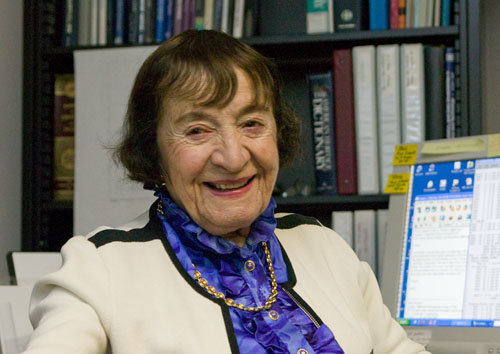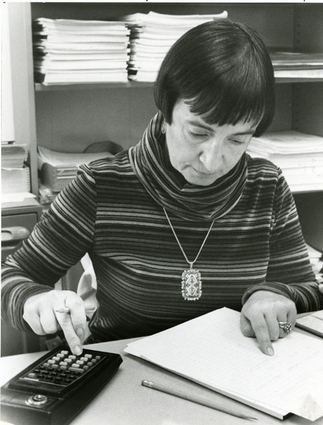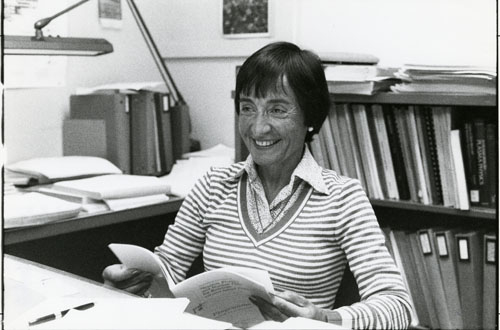Lab treasure celebrates a golden year
In 1959, the microchip was invented, NASA named the first seven Mercury astronauts and Xerox launched its first copier. That also was the year that senior physicist Luisa Hansen joined the Laboratory, which was still in its first decade under the leadership of co-founder Dr. Edward Teller.
Last month, in December, Hansen celebrated 50 years at the Lab. Along the way, she not only has witnessed significant developments on the frontiers of science but has also seen some major changes in the complexion of the Lab's workforce.
Talk with her today and you'll observe her energy, confidence and drive that say: "I'm not going away anytime soon." Right from the start, Hansen was a rarity — one of only a few women scientists to be hired in the 1950s at what was then the Lawrence Radiation Laboratory.
"Why do you work? "male colleagues would ask her.
"They were not used to working with women; they couldn't relate," Hansen explains.
Hansen received her bachelor of science degree in math, with a minor in physics, in her native country of Chile, where while studying and working as a teaching assistant at the university in Santiago, she was introduced by a friend to an American from Wisconsin — the man who would soon become her husband.
They married and headed back to the United States, where she would soon obtain a Ph.D. in experimental nuclear physics from UC Berkeley. Her husband went on to pursue a career in engineering at the Berkeley Lab. But she would look elsewhere.
"At that time, the Berkeley Lab wasn't interested in husband-and-wife teams," she says.
"Many of the companies I applied to weren't interested in hiring a woman," Hansen said, although she did hear back from a few: the Stanford Linear Accelerator, and what was then San Francisco State College, where she was offered a job as associate professor of physics.
Since the couple had settled in Alamo and had a young son to care for, she sought an opportunity closer to home. That's where LLNL fit the bill.
An early assignment brought her to the Lab's B Division as a physicist under the leadership of Hans Mark.
When discussing that era, you can see a twinkle of excitement in her eyes, as she describes how it was — two or three scientists teaming up on independent projects, groups collaborating, but each scientist autonomous.
"I was the only female physicist; I never saw another women that worked in my area," she said.
A decade later, she said, more women began to fill science-related jobs, with the late 1960s seeing deliberate movement to hire more women in biology, chemistry and physics. The world was changing. Perhaps it was during this era when Hansen developed her passion for introducing more young women to science and engineering fields.
Back in 1959, the Lab's workforce was "one color" according to Hansen. "As time went on, more women and more minorities came."
The first 30 years of her Lab career were concentrated in unclassified work, which enabled her to publish more than 170 papers and be invited to present her work and visit laboratories in France, Germany, England, Russia, China and Japan.
Hansen shares a memory of the late Dr. Teller who attended a seminar she gave for the weapons division in the early 1970s. After the presentation, she went to the cafeteria for lunch and saw Teller, but did not try to speak with him. Little did she know he was following her back to her table to congratulate her on her talk. "You walk too fast," he scolded.
Along with giving birth to her son, who is now a computer scientist working in the Silicon Valley, she is proud to measure her life's achievements by milestones in her science career — publishing papers, interacting with top researchers who have come to the Lab, and being recognized by scores of professional organizations.
Throughout her career, Hansen has garnered numerous awards. She was selected a fellow of the American Nuclear Society in 1989 and cited for "development of the LLNL Pulsed Sphere Program; for accomplishments in the measurements of neutron cross sections for defense programs and for fission, fusion and radiation shielding efforts in the United States and worldwide."
She was chosen in 1998 one of the 50 top minority women in science, engineering and technology in the country by the National Technical Association.
Hansen's longtime interest has been to help increase the participation of women in science and engineering, probably an offshoot from her early days when she saw so few female scientists.
She has been a member of the Committee on the Status of Women in Physics and also a member of the Committee on International Freedom of Scientists of the American Physical Society.
She has been an active participant in the annual Expanding Your Horizons in Math and Science conference, as an organizer, workshop leader and presenter.
She served as chairperson for the Scholarship Committees of the Pan American Round Table of Contra Costa y Alameda Counties and Centro Chileno Lautaro of San Francisco. These two organizations lend economic support to college and university students with Hispanic backgrounds.
Hansen has been president of the Walnut Creek branch of the American Association of University Women, and in 1992, served as president of the Lawrence Livermore Laboratory Women's Association (LLLWA).
No group at the Lab has been more influenced by Hansen's involvement than the LLLWA. While president, she catapulted the membership to a record high, often personally making phone calls to employees, and encouraging them to join the association.
"Luisa is a true role model in her dedication to science, furthering the science of the Lab, and encouraging other women to further their education, particularly in technical fields," said Charlene Grandfield of the Environmental Protection Department.
"It is a great pleasure to know Luisa and to have the opportunity to work with her on the LLLWA Scholarship Committee, where she is an energetic, forthright and valued contributor and shows genuine enthusiasm and support for all scholarship applicants who are working hard to advance their education," Grandfield said.
Along with promoting science careers, Hansen has endorsed pay equity for women and in the 1990s, with former Lab employee Mary Singleton, shepherded a salary study report that was presented to then-Lab director John Nuckolls, resulting in a significant increase of women's salaries.
The LLLWA has instituted a scholarship award in Hansen's name, honoring her for her "incredible energy, her undaunted courage in asking the hard questions, and her far-reaching volunteerism," and to be given to "a hard-working recipient with excellent grades, an inquisitive mind and innovative approach to her field or career."
Although 'retirement' is a word not in Hansen's vocabulary, she officially retired in 1996, a fact she doesn't elaborate on nor is it a date on the tip of her tongue. This may be because retirement has not altered her lifestyle — in 1997, she continued her research as a participating guest and has been a Lab associate since 1998. She continues to come to her office in Bldg. 121 each weekday in support of Defense Technologies Engineering and NIF.
Hansen states that the Lab has given her vast opportunities — much independence, good people to work with and a "good career." She tells prospective LLNL employees that there are "many, many fields you can find that would interest you, good people, and freedom to carry on projects with support." Her advice to those beginning their science careers includes: "Be assertive, work very hard and enjoy. Enjoy it because it is not just a job."
It's clear after so many years and so many accomplishments that Hansen has followed her own advice. Her career has exceeded a job — it has been her joy.








